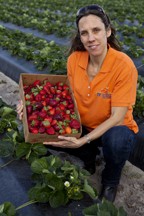Strawberry Monitoring System Could Add $1.7 Million Over 10 Years to Some Farms

Cutline: Natalia Peres, UF/IFAS associate professor of plant pathology, shows a container of strawberries. A new UF/IFAS study shows growers can use the Strawberry Advisory System, a web-based tool that Peres helped design, to save up to $1.7 million over 10 years in fungicide use. Instead of spraying weekly, growers can use the system to tell them more optimal time to spray their strawberries. Courtesy: UF/IFAS file photo.
The Strawberry Advisory System, devised by an Institute of Food and Agricultural Sciences researcher, takes data such as temperature and leaf wetness and tells growers when to spray fungicide to ward off diseases.
Before the system was developed, strawberry farmers traditionally sprayed weekly during the November-to-March growing season. Spraying more often than is needed wastes money and can lead to fungicide resistance, said Natalia Peres, associate professor in plant pathology, who led the system’s development.
Not all strawberry growers use the system, but this research might persuade them to do so, said Tatiana Borisova, an assistant professor in UF/IFAS food and resource economics department.
“The study will help additional producers to realize the benefits,” Borisova said. “Increased adoption of this system can increase the profitability of the strawberry industry in Florida, and it will help producers to stay competitive in the market.”
Ekaterina Vorotnikova, a doctoral student in food and resource economics, worked on the study to identify how much the web tool could increase profits and yield by reducing spraying for anthracnose and botrytis, two of the crop’s deadliest diseases.
Using a 26-acre farm as her average, Vorotnikova took data collected at UF’s Gulf Coast Research and Education Center from 2006-2012 and put it into a 10-year model. She found that using the web tool increased net profit for strawberries with anthracnose by $1.7 million and $890,000 for those with botrytis. The increased profit stemmed mostly from decreased spraying, Borisova said.
Florida is the nation’s second-leading strawberry producer, behind California. Florida’s crop brings in $366 million annually, according to the state Department of Agriculture and Consumer Services.
“Given that world strawberry production was worth about $4.3 billion in 2013, the development and adoption of expert systems for small fruit production operations can benefit millions of farmers worldwide,” Vorotnikova said.
In 2012 and 2013, a UF/IFAS survey found 96 percent of Florida’s strawberry producers said botrytis attacks their crop. Half said they get anthracnose every three to four years, while 40 percent said they get it every year. Fifty-five percent of respondents said they subscribe to text or e-mail alerts about anthracnose and botrytis risk levels from the system, Borisova said.
Traditionally, strawberry growers sprayed their crop with fungicide weekly. But this was not optimal, said John VanSickle, a UF/IFAS food and resource economics professor and a study co-author.
For example, if conditions do not induce diseases, growers sprayed unnecessarily, wasting chemicals and labor and increasing production costs. Second, if weather worsens unexpectedly, farmers might not be able spray. Third, too much fungicide helps build chemical resistance for the disease, VanSickle said.
The study, written by Vorotnikova, Borisova and VanSickle, was published online last month in the journal Agricultural Systems.
Growers can use the system by logging onto www.agroclimate.org/tools/strawberry or use the website to sign up for email or text alerts.
By Brad Buck, 352-294-3303, bradbuck@ufl.edu
Sources: Tatiana Borisova, 352-294-7666, tborisova@ufl.edu
John VanSickle, 352-294-7634, sickle@ufl.edu
Media Contact
More Information:
http://www.ufl.eduAll latest news from the category: Agricultural and Forestry Science
Newest articles

Combatting disruptive ‘noise’ in quantum communication
In a significant milestone for quantum communication technology, an experiment has demonstrated how networks can be leveraged to combat disruptive ‘noise’ in quantum communications. The international effort led by researchers…

Stretchable quantum dot display
Intrinsically stretchable quantum dot-based light-emitting diodes achieved record-breaking performance. A team of South Korean scientists led by Professor KIM Dae-Hyeong of the Center for Nanoparticle Research within the Institute for…

Internet can achieve quantum speed with light saved as sound
Researchers at the University of Copenhagen’s Niels Bohr Institute have developed a new way to create quantum memory: A small drum can store data sent with light in its sonic…





















